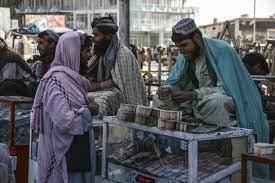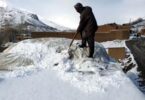KABUL (Khaama Press): A few months ago, Mullah Abdul Ghani Baradar, Afghanistan’s acting Deputy Prime Minister for economic affairs, thanked the World Bank for its thorough evaluation of the nation’s economy. The international institution highlighted that Afghanistan managed to curtail inflation to 18.3% in 2022, which further subsided to 1.94% in March 2023, down from 3.5% the preceding month. As per the national records, exports between January and April 2023 reached USD 600 million, marking a growth of over 4% from the previous year, whereas imports in the period between January and July 2023 surged by 32% from the same timeframe in 2022.
The promising economic indicators, which include local food production enhancement, banking system improvements, and regularized salaries for public servants, led Mawlawi Hibatullah Akhundzada, the Supreme Leader of the Islamic Emirate of Afghanistan (IEA), to issue a decree on August 22. This decree mandates all ministries and relevant agencies to foster trade facilitation at ports, transit points, and highways, with a keen eye on the country’s commercial and economic interests. The decree further emphasized treating the private sector favorably and prioritizing domestic products to bolster local industry growth and self-sufficiency.
The Afghanistan Chamber of Commerce and Investment (ACCI) lauded this decree, with Chairman Mohammad Yunus Momand expressing optimism about future export increases. The ACCI also acknowledged the recent spike in transit transport and made pleas for tax reductions, improved monetary transfer processes abroad, and the promotion of Afghanistan’s clothing manufacturing.
Representatives from the Afghanistan Industry Association highlight the country’s self-sufficiency in 52 sectors, emphasizing the need to address the scarcity of land and energy to bolster local production.
Key economic reforms initiated by the “Taliban 2.0” have contributed to stabilization efforts. These include effective revenue collection, preventing multiple taxation by issuing tax receipts to transporters, and stringent measures against smuggling and corruption.
Despite initial economic downturns, stabilizing signs emerged, attributed partly to UN cash injections for humanitarian assistance, governmental restrictions on illicit imports, and sound macroeconomic management. Yet, the balance remains delicate. A considerable portion of Afghans still struggle to meet basic needs, relying heavily on humanitarian aid.
William Biard, an Afghanistan specialist at the United States Institute of Peace (USIP), commends the Taliban’s economic management but warns of potential future declines reminiscent of the chaos post the Taliban’s takeover in August 2021. The economic plunge was aggravated by factors such as the termination of financial aid, sanctions, and freezing of Afghanistan’s foreign exchange reserves.
Remarkably, despite these adversities, the Taliban’s economic governance has outperformed many expectations. A significant catalyst for this resilience is their inheritance of functional macroeconomic institutions. However, their lackluster attention to social service delivery and limited support for the needy are areas of concern, which now heavily depend on international humanitarian aid.
According to USIP’s analysis, Afghanistan’s fragile economy faces threats from declining humanitarian assistance and the effects of the Taliban’s opium poppy cultivation ban. These factors, combined with depleting household coping mechanisms, suggest a challenging winter ahead for Afghanistan.
To bolster economic recovery, USIP recommends sustained humanitarian support, efficient aid usage, and greater international cooperation focused on private sectors and the broader economy.







